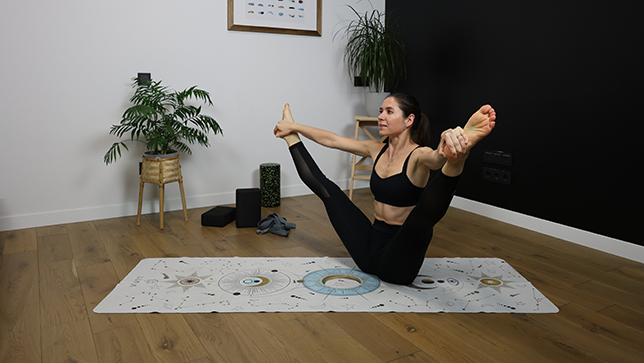Upward Facing Wide-Angle Seated Pose - Urdhva Upavistha Konasana

Contents
Upward Facing Wide-Angle Seated Pose, also known as Urdhva Upavistha Konasana (Uerd-vah oo-pah-veest-ah kone-ah-sah-nah), is a challenging seated yoga posture that offers many benefits to the body and mind.
Urdhva Upavistha Konasana” consists of four Sanskrit words:
“Urdhva” — meaning “upright”
“Upavistha” — meaning “seated” or “sitting”
“Kona” — meaning “angle”
“Asana” — meaning “pose” or “posture”.
Urdhva Upavistha Konasana is an excellent pose for opening the hips, hamstrings, and lower back. It also helps to strengthen the legs and core, improve posture, and increase flexibility in the spine. Additionally, this pose can be beneficial for improving digestion and reducing stress and anxiety.
Overall, Upward Facing Wide-Angle Seated Pose is an excellent addition to any yoga practice, offering a host of physical and mental benefits. With consistent practice, this posture can help you build strength, flexibility, and balance, while also promoting relaxation and inner calm.
Pose Detail
- By Type: Balancing Yoga Poses, Chest Opening Yoga Poses, Flexibility Yoga Poses, Hip Opening Yoga Poses, Strengthening Yoga Poses
- Difficulty: Intermediate
- Body Position: Seated Yoga Poses
- By Benefit: Yoga Poses For Digestion, Yoga Poses For Stress Relief
Step-by-Step Instructions
Benefits and Contraindications
Improves overall flexibility
Strengthens and tones the abs, spine and legs.
Opens the hips and back of the legs
Improves balance, focus and concentration
Stimulates the abdominal organs, improving digestion
Pregnancy or menstruating
Sciatica
Lower-back injury
Issues in the neck, shoulder, hip, chest, elbows
High blood pressure
Hernia or slip disc
Modifications, Props and Tips
- If you have difficult for you to keep your balance, you can train against the wall.
- If you have difficulty reaching your feet, you can use a strap to help you lengthen your spine and keep your chest lifted. Place the strap around the balls of your feet, and hold onto the ends with your hands. This will help you maintain proper alignment and prevent rounding of the spine.
- If you have difficulty keeping your legs straight, you can bend your knees slightly or place a blanket under your hips. This will help you engage your leg muscles and maintain stability in the pose.
- If you have tight hips or inner thighs, you can adjust the angle of your legs to make the pose more comfortable. Instead of spreading your legs wide apart, try bringing them closer together and pointing your toes outward. This will help you open up your hips and inner thighs gradually.
Frequently Asked Questions
Yes, beginners can practice Urdhva Upavistha Konasana, but they should approach the pose with caution and use props as needed. It is important to work within your own range of motion and avoid forcing the body into the pose.
You can hold Urdhva Upavistha Konasana for 30 seconds to 1 minute, or longer if it feels comfortable. It is important to breathe deeply and relax into the pose.
Common mistakes include rounding the spine, forcing the legs too far apart, and forgetting to engage the leg muscles. It is important to maintain proper alignment and work within your own range of motion.
Urdhva Upavistha Konasana is not recommended during pregnancy, as it puts pressure on the abdominal muscles and pelvic floor. Pregnant women should consult a healthcare professional before practicing any new yoga poses.
Variations
- Wide Angle Seated Forward Bend Pose
- Seated Straddle Pose
- Complete Boat Pose
- Standing Wide Legged Forward Fold Pose